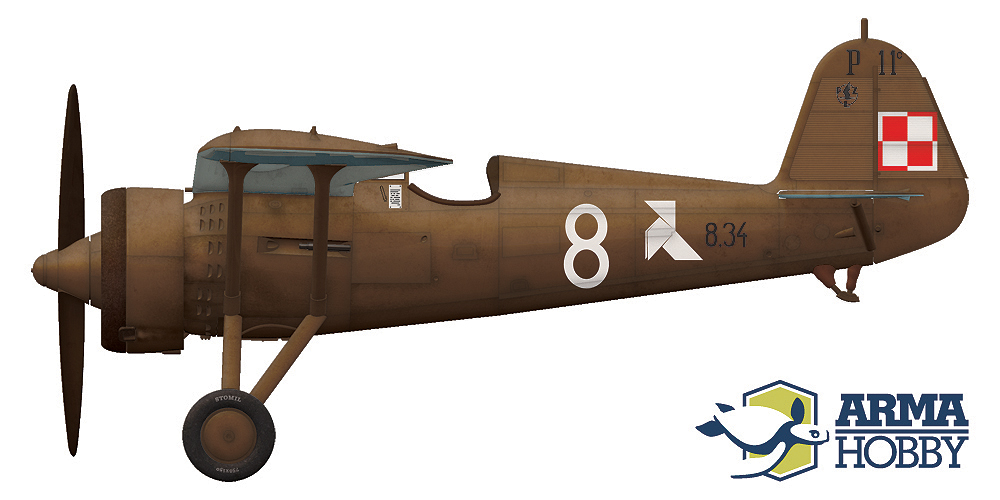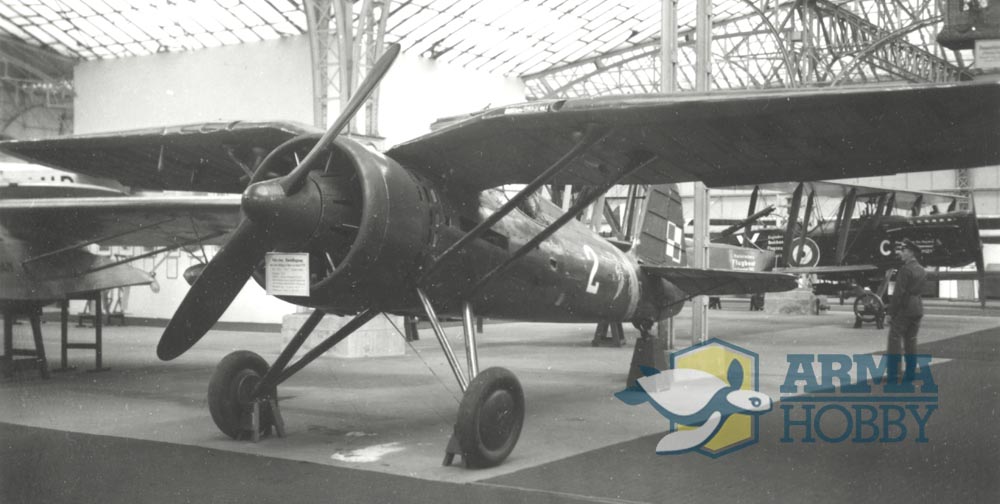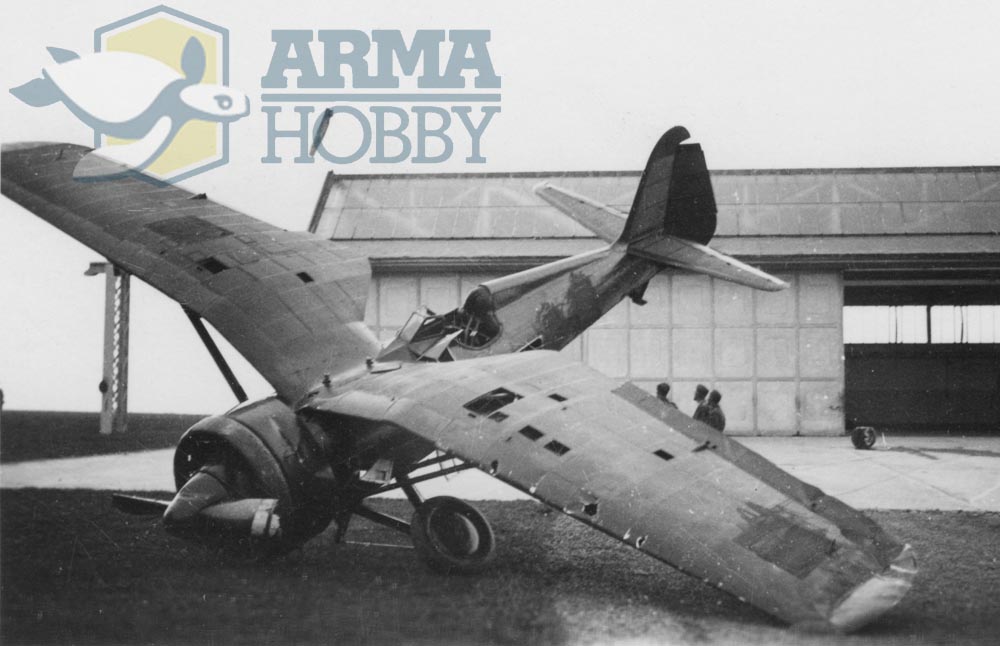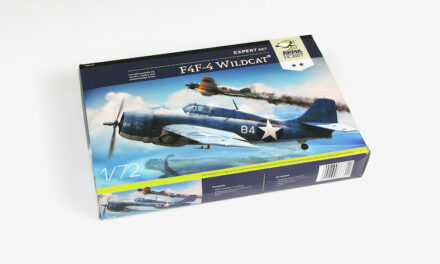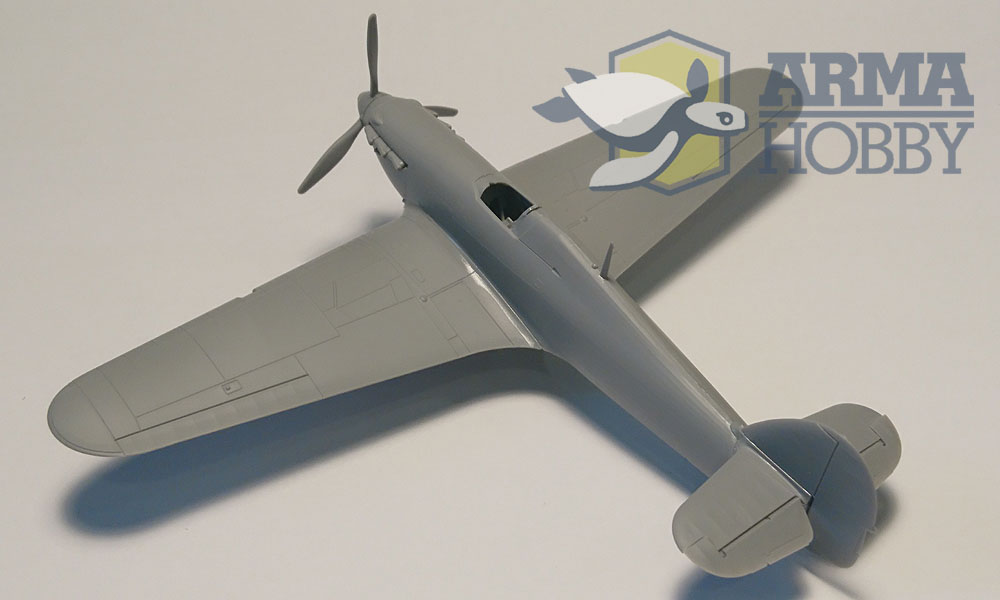1/72 Arma Hobby PZL P.11c model kit in JUNIOR box version includes decals for the “eleven” in two painting schemes from Cracow III/2 Fighter Wing: “white 2” from the Polish Aviation Museum collection, which was flown in 121. Fighter Squadron by 2nd Lt. Wacław Król, and the „white 8” from 122. Fighter Squadron, used by Cadet Władysław Chciuk.
See part one of P.11’s from Cracow
Panting scheme anatomy
Performed in the ‘80s thorough examination of the Museum example of the PZL P.11c, which preceded the overhaul of its airframe, has been described in the report, available on the Museum website (in Polish, but with many interesting drawings). The report describes subsequent layers of various paints applied on the airplane, in the factory, the squadron, in the German collection and finally in Polish Museum.
Initially, in the factory, the whole airframe, both on internal and external surfaces, had been primed with aluminium coloured paint. Then all the external surfaces (including undersurfaces!) have been painted with khaki camouflage paint (“olive brown” according to the report, presently this shade is known as “light Polish khaki” or “early Polish khaki”). The third layer was the light blue-grey on the wing and tailplane undersurfaces. Next, still in the factory, the national markings (checkerboards) and red stencils were applied.
Military serial number “8.63”, tactical number “2” and the squadron marking (white winged lightning) have been applied in the squadron, using white paint. Blue paint has been used for diagonal fuselage bands and “arrow” on the top wing surface, and black for “39 E” marking on the wing bottom. We can assume that this was the complete scheme for this airplane in first years of its service. Similar painting and marking procedure has been probably used for all the Polish PZL P.11 fighters, of course with specific markings for each squadron.
After some period of service – most probably during the overhaul – the painting was refreshed. Top and side surfaces have been painted again with the khaki camouflage paint, but with darker shade (so called “dark” or “late Polish khaki”). Wing and tailplane undersurfaces were painted with grey-blue, but darker and more greyish. Blue bands were refreshed. Black “E” letter under one of the wings was replaced with “K”, while the “39” number remained unchanged. Most probably in such scheme the airplane went to the war in September 1939.
Captured PZL P.11c “8.63” “white 2” in Berlin collection. Photo from dr Tomasz Kopański collection
Zdobyta przez Niemców PZL P.11c „8.63” „biała 2” na wystawie w Berlinie. Zdjęcie z kolekcji dr. Tomasza Kopańskiego
Next scheme, described in the report as „post war I”, includes dark green paint on the top and side surfaces (stencils and blue arrow on the top wing are overpainted), and light blue on the undersurfaces. White fields were added to the big checkerboards on the wing undersurfaces (initially the bottom checkerboards have been in “low-visibility” variant without white). Squadron marking has been roughly repainted by hand without use of the mask. After examination of the known photos one can assume, that it has been probably done by the Germans in Berlin collection. There is a photo showing the plane Berlin exhibition with the wing blue arrow already overpainted. The colours used may be of German RLM range?
The report describes also the „post war II” scheme, including re-painting of the „P.11c” on the tail, painting the propeller in black and the propeller hub partially in white. This description fits the scheme known from the post war photos of the airplane taken during various public exhibitions and shows.
Present painting scheme was applied after the professional overhaul made in the Warsaw PZL factory in 1986-1989. It is not fully historical, but it is remembered by the great numbers of Museum visitors and widely known thanks to thousands of photographs taken and published in the books and shared in the Internet. That’s why this scheme has been chosen for the PZL P.11c 1/72 JUNIOR Arma Hobby model kit.
Detail of the captured PZL P.11c “8.63” in Berlin collection. Note holes for the removed wing machine guns, empty cartridge chutes and the bomb racks visible on the red area of the checkerboard. Photo from dr Tomasz Kopański collection
The airplane has the wing machine guns installed (in the Museum the extended empty cartridge chutes are not present, but in Berlin these were still installed). The bomb racks are – typically for the later production series – closer to the wingtips. Unfortunately, the original wheels have been lost. The airplane in the Museum is presented with replacement wheels of smaller diameter.
PZL P.11c “white 8” on Aleksandrowice airfield. Note the overpainted white “8” number and squadron marking. Military serial and “P.11c” on the tail are painted in black. Photo from dr Tomasz Kopański collection
„White 8” from Aleksandrowice
Used on the Aleksandrowice ambush PZL P.11c of Władysław Chciuk with the white “8” and “8.34” military serial is well known from numerous German photos taken after the capture of the airfield. The plane shows “low-visibility” scheme typical for forward airfields of September 1939, known also from Poznań 3rd Air Regiment squadrons. In order to more effectively hide the airplanes from the eyes of the Dorniers spying over the secret landing grounds close to the enemy border, the checkerboards on the top wing surfaces, on the tail, and the fuselage tactical numbers and squadron markings have been overpainted. Most probably diluted, not fully covering camouflage paint was used. On some photos we can identify the number “8” and “the paper horse” despite the layer of camouflage paint. Serial number was repainted in black. Markings on the wing undersurfaces remained unchanged.
PZL P.11c “white 8” on Aleksandrowice airfield. Note the overpainted wing checkerboards, fuselage number and squadron marking. Photo from dr Tomasz Kopański collection
The airplane, coming from the earlier production series, had the bomb racks closer to the wing roots. Using the kit decals modeller can build model of this airplane both in the pre-war variant with full markings and in the wartime option with the markings and checkerboards overpainted.
Advertisement
Markings of both aircraft descried in this article are included in 70016 PZL P.11c Junior Set 1/72!
Modeller, son and father of a modeller. Loves digging through references and analysing old photographs. He builds aircraft, ship and vehicle models, the older the better. He has a weakness for Polish equipment, but does not despise the RAF, FAA and Great War topics. A journalist by training.
This post is also available in:
 polski
polski


